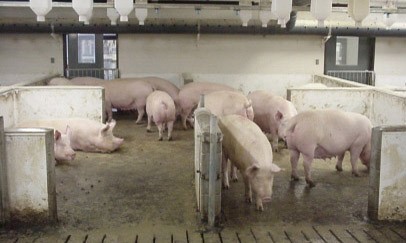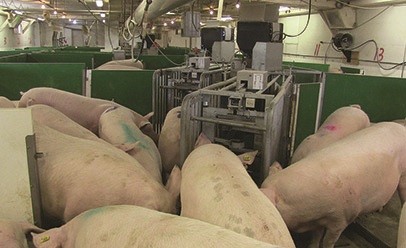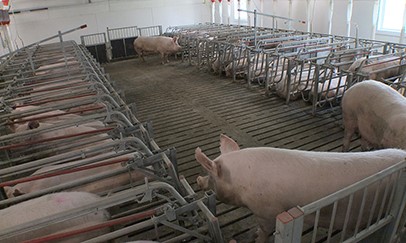Group housing systems for gestating sows
Learn about group housing systems for gestating sows, including code of practice requirements. This technical information is for commercial swine producers in Ontario.
ISSN 1198-712X, Published November 2017
Introduction
A good sow housing system strikes a balance between producer and animal requirements. Considerations for housing systems focus on economics, animal welfare and management styles. A variety of housing systems for sows are used in Ontario, including group and individual housing. Increasing welfare concerns of consumers and the changing Code of Practice for the Care and Handling of Pigs are causing a shift towards group housing in the swine industry in both Ontario and Canada. This factsheet provides basic information on group housing for gestating sows and will direct you towards resources that cover the topic in more depth.
Code of practice requirements
In 2014, the National Farm Animal Care Council (NFACC) released an updated version of its Code of Practice for the Care and Handling of Pigs. It states that for all holdings newly built or rebuilt or brought into use for the first time after July 1, 2014, mated gilts and sows must be housed in groups.
Additionally, the document states that As of July 1, 2024, mated gilts and sows must be housed in groups, individual pens or in stalls if they are provided with the opportunity to turn around or exercise periodically.
The definition of exercise is still to be determined by the scientific committee of the Code of Practice, and the NFACC will clarify these exercise options by July 1, 2019. In all cases, individual stalls may be used for up to 28 days after the date of the last breeding, and an additional period of up to 7 days is permitted to manage grouping.
Group housing
Group housing allows freedom of movement, increased exercise and social interactions, which are essential components of animal welfare. However, housing sows in groups increases the difficulty of monitoring herd dynamics and may provide opportunities for aggressive interactions between animals. Studies show that in group systems that are well designed and managed, reproductive performance of sows in groups is equal to, or better than, that of sows in stalls. Additionally, a survey of Ontario farms found increases in the number of litters/sow/year in group-housed sows.
Competitive group housing systems
In a competitive group housing system, sows may try to gain additional feed using aggressive behaviour. As much as possible, group sows by parity, size and/or body condition to help reduce aggressive interactions at feeding. Floor feeding and non-gated (shoulder) stalls are common. These systems typically have a low capital investment, but producers must be confident of their management skills to minimize aggressive behaviour of sows.
Floor feeding
Floor feeding requires the lowest capital investment but high levels of management (Figure 1). In these systems, dominant sows have increased feed intake and weight gain compared to submissive sows. Spreading out feed drops and providing dividers in pens helps reduce aggression in these systems.

Non-gated stalls
Non-gated stalls (Figure 2), also called shoulder stalls, require low capital investment but high levels of management. Feed is provided in equal amounts to each "stall" along a trough, and partitions provide protection around the head and shoulders of the sows, helping reduce aggression and injury. Feeding wet diets or using a trickle feeding system set to the eating speed of the slowest sow in the group will help decrease aggressive interactions.
Non-competitive group housing systems
Non-competitive group housing prevents sows from gaining feed through aggressive behaviour, however there may still be aggression in front of the feeder as sows attempt to gain quicker access. Three common non-competitive group housing systems are available: the electronic sow feeder, free-access stalls and the free-access-electronic sow feeder combination.
Electronic sow feeders
An electronic sow feeder (ESF) system (Figure 3) requires moderate capital investment and management. An ESF system provides one feeding station for a group of sows (up to 60 sows, depending on the system). Individual feed curves can be programmed into the computer, and there is increased opportunity for exercise and social interaction. The ESF feeding station is controlled by a computer that scans the sow's ear tag when she enters the feeding stall and delivers the appropriate ration for each sow. Competition is reduced because the sows have access to the feeder at all times. They can eat their daily ration all at once or visit the feeder several times throughout the day.
Training gilts to use the system is critical to its success. Employees should understand the computer system in order to identify sows that are not eating and may require additional attention due to injury or illness. ESF systems can also be used to sort sows, feed multiple different diets and identify sows that have returned to estrus.
Free-access stalls
Free-access stalls (Figure 4) require high capital investment and increased floor space, but less-intensive animal management compared to other systems. Free-access stalls allow the sows to feed at the same time and prevent dominant sows from stealing feed from submissive sows. Sows enter stalls at feeding time through a back gate and can leave the stall at any time.



A stall must be provided for each sow in the group, and individual feeding curves cannot be used. It is important to identify and train sows having difficulties with the stalls to ensure they are receiving all the benefits of group housing by spending time in the loafing area (free space). Placing resources and toys, and improving comfort in the loafing area will encourage sows to use the space.
Free-access electronic sow feeders
Free-access electronic sow feeders (Figure 5) are a relatively new form of non-competitive group housing that is available at an intermediate cost. This housing system combines the advantages of ESF and free-access stalls. Individual feeding of the sows uses radio frequency identification (RFID) ear tags and programmable feed curves, similar to standard ESF equipment.
This system requires considerably less pen space than free-access stalls. The stalls can easily be used by sows; however, some may require training. Aggression during feeding is reduced in this system because of the lower sow-to-feeder ratio (20:1). This system has low maintenance requirements because it is less complex mechanically compared to typical ESF systems.

This factsheet was written by Laura Eastwood, Swine Specialist, OMAFRA, Stratford.
Footnotes
- footnote[i] Back to paragraph Prairie Swine Centre. Science of Ethology. Available in hard copy or online.
- footnote[ii] Back to paragraph National Sow Housing Conversion Project (NSHCP).
- footnote[iii] Back to paragraph Prairie Swine Centre. Science of Ethology. Available in hard copy or online.
- footnote[iv] Back to paragraph National Farm Animal Care Council. Code of Practice for the Care and Handling of Pigs. 2014.